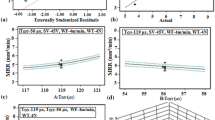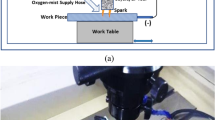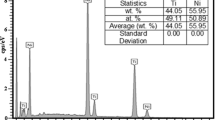Abstract
Nickel–titanium (NiTi) shape memory alloy has diverse applications, especially in areas such as the medical, aerospace, and aeronautical industries. Due to this alloy’s excellent fatigue strength, high mechanical properties even at higher temperatures, and tendency to corrosion resistance, NiTi alloy is considered difficult to machine. In the present scenario, electrochemical arc machining ECAM (hybrid of electric discharge erosion and electrochemical dissolution) is an evolving procedure for difficult to machine the materials due to constraints of existing processes. The present research aims to investigate the machinability of Ni55.7Ti alloy through electrochemical arc drilling using molybdenum electrode. Electrolyte concentration (ethanol with ethylene glycol and sodium chloride), supply voltage, and tool rotation are considered as the variable factors in order to evaluate the ECAM performance characteristics in drilling blind hole operation concerning overcut, tool wear rate, and materials removal rate. Consequently, response surface methodology is implemented for predictive modeling of various performance characteristics. Finally, multi-objective optimization through DFA has produced a set of optimal parameters to improve the productivity along with the accuracy, which is the prime requirement for the industrial applicability of the ECAM process. Results demonstrated that supply voltage is the influential key factor for improvement of machining rate. SEM photographs revealed the development of HAZ, white layer, melted droplet, craters, re-solidified material, ridge-rich surface, and voids as well as cavities around the end-boundary surfaces of a blind hole. Composition analysis through EDS indicated the oxygen content on the machined surface because electrolyte breakdown causes oxidation to take place at elevated temperatures across the machining zone. Moreover, carbide precipitation like TiC was found in the melting zone of the drilled hole which has the affinity to reduce the SMA properties in HAZ.




















Similar content being viewed by others
References
Kedare R et al (2018) Review on WEDM of shape memory alloy. Mater Today Proc 5(14):28313–28319
Song G, Ma N, Li H (2006) Applications of shape memory alloys in civil structures. Eng Struct 28(9):1266–1274
Huang W (2002) On the selection of shape memory alloys for actuators. Mater Des 23(1):11–19
Kumar SM, Lakshi MV (2013) Applications of shape memory alloys in MEMS devices. Int J Adv Res Comput Commun Eng 2(2):1122–1127
Duerig T, Pelton A, Stöckel D (1999) An overview of nitinol medical applications. Mater Sci Eng, A 273–275:149–160
Gil FJ, Planell JA (1998) Shape memory alloys for medical applications. Proc Inst Mech Eng 212(6):473–488
Thompson SA (2000) An overview of nickel–titanium alloys used in dentistry. Int Endod J 33(4):297–310
Marchand C, Heim F, Durand B, Chafke N (2011) Nitinol stent for percutaneous heart valve implantation: material shape setting. Mater Manuf Processes 26(2):181–187
Morgan NB (2004) Medical shape memory alloy applications—the market and its products. Mater Sci Eng, A 378(1–2):16–23
Lagoudas DC, Rediniotis OK, Khan MM (2000) Applications of shape memory alloys to bioengineering and biomedical technology. In: Scattering theory and biomedical engineering modelling and applications, pp 195–207
Sutapun B, Tabib-azar M, Huff MA (1998) Applications of shape memory alloys in optics. Appl Opt 37(28):6811–6815
Miyazaki S, Sachdeva RL (2008) Shape memory effect and superelasticity in Ti–Ni alloys. Shape Memory Alloys Biomed Appl 3–19
Bogue R (2009) Shape-memory materials: a review of technology and applications. Assem Autom 29(3):214–219
Weinert K, Petzoldt V (2004) Machining of NiTi based shape memory alloys. Mater Sci Eng A 378(1-2 SPEC. ISS.):180–184
Lin HC, Lin KM, Chen YC (1999) The laser machining characteristics of TiNi shape memory alloys. High Temp Mater Process 3(4):409–420
Majumder H, Maity K (2018) Prediction and optimization of surface roughness and micro-hardness using Grnn and MOORA-fuzzy-a MCDM approach for nitinol in WEDM. Measurement 118:1–13
Jatti VS (2018) Multi-characteristics optimization in EDM of NiTi Alloy, NiCu alloy and BeCu alloy using taguchi’s approach and utility concept. Alex Eng J 57(4):2807–2817
Abidi MH, Al-Ahmari AM, Umer U, Rasheed MS (2018) Multi-objective optimization of micro-electrical discharge machining of nickel–titanium-based shape memory alloy using MOGA-II. Meas J Int Meas Confed 125:336–349
Abidi M et al (2017) An investigation of the micro-electrical discharge machining of nickel–titanium shape memory alloy using grey relations coupled with principal component analysis. Metals 7(11):486
Jahan MP, Kakavand P, Alavi F (2017) A comparative study on micro-electro-discharge-machined surface characteristics of Ni–Ti and Ti–6Al–4V with respect to biocompatibility. Proc Manuf 10:232–242
McGeough JA, Khayry ABM, Munro W, Crookall JR (1983) Theoretical and experimental investigation of the relative effects of spark erosion and electrochemical dissolution in electrochemical ARC machining. CIRP Ann Manuf Technol 32(1):113–118
Chandrasekhar S, Prasad N (2020) Multi-response optimization of electrochemical machining parameters in the micro-drilling of AA6061-TiB2in situ composites using the Entropy–VIKOR method. Proc Inst Mech Eng Part B J Eng Manuf 234(10):1311–1322
Krötz H, Roth R, Wegener K (2013) Experimental investigation and simulation of heat flux into metallic surfaces due to single discharges in micro-electrochemical arc machining (Micro-ECAM). Int J Adv Manuf Technol 68(5–8):1267–1275
Krötz H, Wegener K (2015) Sparc assisted electrochemical machining: a novel possibility for microdrilling into electrical conductive materials using the electrochemical discharge phenomenon. Int J Adv Manuf Technol 79(9–12):1633–1643
Ao S et al (2020) Electrochemical micromachining of niti shape memory alloy with ethylene glycol–NaCl electrolyte containing ethanol. J Manuf Process 53:223–228
Younas M et al (2019) Multi-objective optimization for sustainable turning Ti6Al4V alloy using grey relational analysis (GRA) based on analytic hierarchy process (AHP). Int J Adv Manuf Technol 105(1–4):1175–1188
Wang D, Zhao J (2016) Design optimization of mechanical properties of ceramic tool material during turning of ultra-high-strength steel 300M with AHP and CRITIC method. Int J Adv Manuf Technol 84(9–12):2381–2390
Patel Gowdru Chandrashekarappa M et al (2021) Experimental analysis and optimization of EDM parameters on Hchcr steel in context with different electrodes and dielectric fluids using hybrid Taguchi-based Pca-utility and critic-utility approaches. Metals 11(3):1–22
Rao KV, Murthy PBGSN, Vidhu KP (2017) Assignment of weightage to machining characteristics to improve overall performance of machining using GTMA and utility concept. CIRP J Manuf Sci Technol 18:152–158
Adarsha Kumar K, Ratnam C, Venkata Rao K, Murthy BSN (2019) Experimental studies of machining parameters on surface roughness, flank wear, cutting forces and work piece vibration in boring of AISI 4340 steels: modelling and optimization approach. SN Appl Sci 26:1–12
Reddy MC, Rao KV, Suresh G (2021) An experimental investigation and optimization of energy consumption and surface defects in wire cut electric discharge machining. J Alloy Compd 861:158582
Rao KV, Kumar YP, Singh VK, Prasad BS (2022) Online modeling and monitoring of power consumption, aerosol emissions, and surface roughness in wire cut electric discharge machining of Ti–6Al–4 V. Int J Adv Manuf Technol 119:3205–3222
Mishra DK, Dixit P (2021) Experimental investigation into tool wear behaviour of line-array tool electrode during the electrochemical discharge micromilling process. J Manuf Process 72:93–104
Ma Y, Yin Y, Zhang J, Huo J (2022) Effects of processing parameters on the surface quality of wrought Ni-based superalloy by ultrasonic-assisted electrochemical grinding. Int J Adv Manuf Technol 121(11–12):7851–7865
Sethi A, Acharya BR, Saha P (2022) Study of the electrochemical dissolution behavior of Nitinol shape memory alloy in different electrolytes for micro-ECM process. Int J Adv Manuf Technol 121(9–10):7019–7035
Pawar P, Kumar A, Ballav R (2019) Parametric analysis of electrochemical discharge drilling on soda-lime glass material using taguchi L27 orthogonal array method. Strojnícky časopis-J Mech Eng 69(4):115–132
Rashedul IM, Zhang Y, Zhou K, Wang G, Xi T, Ji L (2021) Influence of different tool electrode materials on electrochemical discharge machining performances. Micromachines 12(9):1077
Bhargav KVJ, Balaji PS, Sahu RK, Leblouba M (2022) Experimental investigation on machining characteristics of titanium processed using electrolyte sonicated µ-ECDM system. Sci Rep 12(1):15540
Magabe R, Sharma N, Gupta K, Paulo Davim J (2019) Modeling and optimization of wire-EDM parameters for machining of Ni55.8Ti shape memory alloy using hybrid approach of taguchi and NSGA-II. Int J Adv Manuf Technol 102(5–8):1703–1717
Antil P, Singh S, Manna A (2020) Experimental investigation during electrochemical discharge machining (ECDM) of hybrid polymer matrix composites. Iran J Sci Technol Trans Mech Eng 44(3):813–824
Yin Y, Zhang J, Ma Y, Huo J, Zhao K, Meng X, Yin J (2020) Electrochemical dissolution behavior of nickel-based Hastelloy X superalloy at low current densities. IEEE Access 8:62714–62724
Bhattacharyya B, Munda J (2003) Experimental investigation on the influence of electrochemical machining parameters on machining rate and accuracy in micromachining domain. Int J Mach Tools Manuf 43(13):1301–1310
Pujari SR, Koona R, Beela S (2018) Surface integrity of wire EDMed aluminum alloy: a comprehensive experimental investigation. J King Saud Univ Eng Sci 30(4):368–376
Gaikwad MU, Krishnamoorthy A, Jatti VS (2019) Investigation and optimization of process parameters in electrical discharge machining (EDM) process for NiTi 60. Mater Res Express 6(6):065707
Pradhan BB, Masanta M, Sarkar BR, Bhattacharyya B (2009) Investigation of electro-discharge micro-machining of titanium super alloy. Int J Adv Manuf Technol 41(11–12):1094–1106
Goyal A, Rahman HUR, Ghani SAC (2021) Experimental investigation & optimisation of wire electrical discharge machining process parameters for Ni49Ti51 shape memory alloy. J King Saud Univ Eng Sci 33(2):129–135
Chaudhari R, Vora JJ, Vivek Patel LN, de Lacalle L et al (2020) Effect of WEDM process parameters on surface morphology of nitinol shape memory alloy. Materials 13(21):4943
Soni H, Narendranath S, Ramesh MR (2018) Effect of machining process parameters on productivity rate and surface roughness of machined TiNiCo alloy. Mater Today Proc 5(9):19166–19171
Bisaria H, Shandilya P (2019) Study on crater depth during material removal in WEDC of Ni-rich nickel-titanium shape memory alloy. J Braz Soc Mech Sci Eng 41(3):157
Chaudhari R, Vora JJ, Vivek Patel LN, de Lacalle L et al (2020) Surface analysis of wire-electrical-discharge-machining-processed shape-memory alloys. Materials 13(3):530
Gupta DK, Dubey AK (2021) Multi process parameters optimization of wire-EDM on shape memory alloy (Ni54.1Ti) using taguchi approach. Mater Today Proc 44(1):1423–1427
Theisen W, Schuermann A (2004) Electro discharge machining of nickel–titanium shape memory alloys. Mater Sci Eng A 378(1-2 SPEC. ISS.):200–204
Daneshmand S et al (2013) Experimental investigations into electro discharge machining of NiTi shape memory alloys using rotational tool. Int J Electrochem Sci 8:7484–7497
Al-Ahmari A, Rasheed MS, Mohammed MK, Saleh T (2015) A hybrid machining process combining micro-EDM and laser beam machining of nickel-titanium based shape memory alloy. Mater Manuf Process 31(4):447–455
Kulkarni VN, Gaitonde VN, Kadadevaru SG, Karnik SR (2019) Simultaneous optimization of material removal rate and tool wear rate during wire electric discharge machining of nitinol smart alloy. AIP Conf Proc 2200:020034
Hasçalik A, Çaydaş U (2007) Electrical discharge machining of titanium alloy (Ti–6Al–4V). Appl Surf Sci 253(22):9007–9016
Azam M et al (2016) Parametric analysis of recast layer formation in wire-cut EDM of HSLA steel. Int J Adv Manuf Technol 87(1–4):713–722
Newton TR et al (2009) Investigation of the effect of process parameters on the formation and characteristics of recast layer in wire-EDM of inconel 718. Mater Sci Eng A 513–514(C):208–215
Naik S, Das SR, Dhupal D (2021) Experimental investigation, predictive modeling, parametric optimization and cost analysis in electrical discharge machining of Al–SiC metal matrix composite. SILICON 13:1017–1040
Roy R, Ghosh SK, Kaisar TI, Ahmed T, Hossain S, Aslam M, Rahman MM (2022) Multi-response optimization of surface grinding process parameters of AISI 4140 alloy steel using response surface methodology and desirability function under dry and wet conditions. Coatings 12(1):104
Author information
Authors and Affiliations
Corresponding author
Additional information
Publisher's Note
Springer Nature remains neutral with regard to jurisdictional claims in published maps and institutional affiliations.
Rights and permissions
Springer Nature or its licensor (e.g. a society or other partner) holds exclusive rights to this article under a publishing agreement with the author(s) or other rightsholder(s); author self-archiving of the accepted manuscript version of this article is solely governed by the terms of such publishing agreement and applicable law.
About this article
Cite this article
Kumar, N., Kumar, A., Sethy, S. et al. Investigation and optimization in electrochemical arc drilling of Ni55.7Ti nickel–titanium shape memory alloy with molybdenum electrode. J Braz. Soc. Mech. Sci. Eng. 45, 448 (2023). https://doi.org/10.1007/s40430-023-04374-9
Received:
Accepted:
Published:
DOI: https://doi.org/10.1007/s40430-023-04374-9




